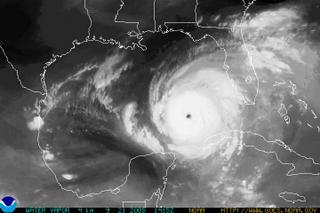Last February, the Houston Chronicle ran a short article by Eric Berger describing an engineering model of the "worst case scenario" for a hurricane strike near Houston.
A landfall here would allow its powerful upper-right quadrant, where the waves move in the same direction as the storm, to overflow Galveston Bay. Within an hour or two, a storm surge, topping out at 20 feet or more, would flood the homes of 600,000 people in Harris County. The surge also would block the natural drainage of flooded inland bayous and streams for a day or more.They're looking at damage that could total "as much as $40 billion to $50 billion," or "approximately the city of Houston's entire budget for the next 15 years."
Coastal residents who ignored warnings to flee would have no hope of escape as waters swelled and winds roiled around their homes. Very likely, hundreds, perhaps even thousands, would die.
Meanwhile, as the storm moved over western Harris County, its most dangerous winds, well in excess of 120 mph even inland, would lash the Interstate 45 corridor, including Clear Lake, the Texas Medical Center and downtown.
Many older buildings could not withstand such winds.
Anything not tied down, from trees to mobile homes to light poles, would become missiles, surreally tumbling and flying through the air, flattening small houses, shattering skyscraper windows and puncturing roofs.
* * *
Various studies of a large storm hitting the Houston area have estimated that 100,000 to 125,000 homes would be destroyed.








No comments:
Post a Comment